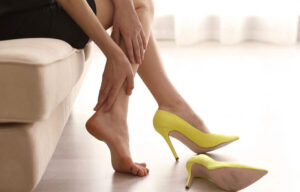
High heels are a fashion staple for many, adding a touch of elegance and height to any outfit. However, the impact they can have on your foot and ankle health is often overlooked. Wearing high heels regularly can lead to a variety of foot problems, ranging from minor discomfort to serious conditions that may require medical attention. Understanding these effects and taking steps to minimize damage is crucial for maintaining healthy feet without sacrificing style.
The Effects of High Heels on Foot and Ankle Health
High heels alter the natural alignment of your feet, placing excessive pressure on the ball of the foot and the toes. This unnatural positioning can lead to several foot-related issues:
- Foot Pain: The elevated heel shifts your body weight forward, increasing pressure on the forefoot. This can cause significant pain in the ball of the foot (metatarsalgia) and lead to chronic discomfort.
- Bunions: High heels, particularly those with narrow toe boxes, can contribute to the development of bunions—a painful bony bump that forms on the joint at the base of the big toe. The pressure and squeezing of the toes can exacerbate this condition over time.
- Hammertoes: The constant pressure from high heels can force the toes into a bent position, leading to hammertoes. This deformity occurs when the toe joints become permanently bent, causing pain and difficulty with shoe fitting.
- Achilles Tendon Issues: Wearing high heels shortens the Achilles tendon, which can cause stiffness and pain in the back of the heel. Over time, this can lead to tendonitis or even a rupture in severe cases.
- Ankle Sprains: High heels, especially stilettos, provide less stability and increase the risk of ankle sprains. The higher the heel, the more likely it is for the foot to twist, leading to a painful sprain or worse.
Tips to Minimize Damage from High Heels
While it may be unrealistic to completely give up high heels, there are ways to minimize their impact on your foot health:
- Choose the Right Heel Height: Opt for heels that are 2 inches or lower to reduce pressure on the forefoot. If you prefer higher heels, consider wearing them for shorter periods or alternating with lower heels throughout the day.
- Look for Supportive Features: Select heels with a wider base, like block heels or wedges, to provide more stability. Shoes with cushioned insoles or arch support can also help distribute pressure more evenly.
- Stretch and Strengthen Your Feet: Regularly stretching your calves and Achilles tendons can help maintain flexibility and reduce the risk of stiffness. Strengthening exercises for your feet and ankles can also improve stability and reduce injury risk.
- Give Your Feet a Break: Avoid wearing high heels every day. Give your feet time to recover by alternating with supportive, flat shoes or sneakers that provide adequate arch support.
- Consider Custom Orthotics: If you frequently wear high heels, custom orthotics designed to fit inside your shoes can offer additional support and reduce the risk of injury.
The Takeaway
High heels, while stylish, can have significant effects on your foot and ankle health. From bunions and hammertoes to chronic foot pain, the consequences of regular high heel wear shouldn’t be taken lightly. By making informed choices about your footwear and taking preventive measures, you can minimize damage while still enjoying the fashion benefits of high heels.
If you’re experiencing foot pain or discomfort related to wearing high heels, contact Southwest Foot and Ankle Center today. Our expert team can assess your condition and recommend treatments or strategies to keep your feet healthy and pain-free. Don’t let foot pain slow you down — reach out to us for the care you need!
Contact us
Schedule an appointment
with our podiatrist by contacting us or calling our:
